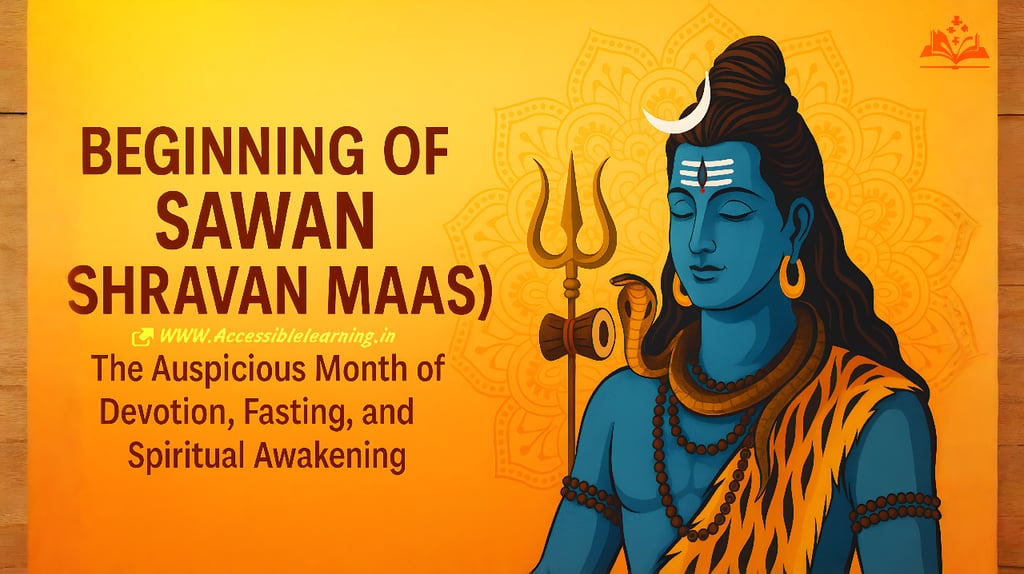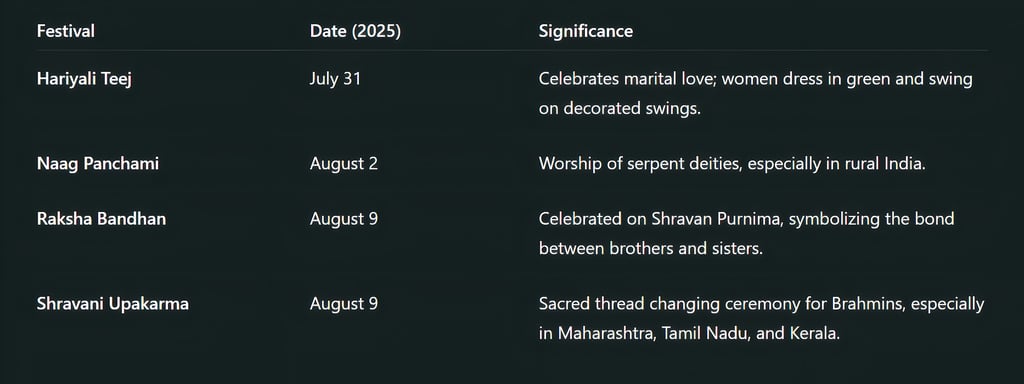
Beginning of Sawan (Shravan Maas): The Auspicious Month of Devotion, Fasting, and Spiritual Awakening
Explore the sacred significance of Sawan (Shravan Maas), its rituals, fasting rules, mythological roots, and regional traditions. Discover how this holy month dedicated to Shiv Ji brings spiritual transformation and divine blessings.
CULTURE/TRADITIONEVENT/SPECIALCELEBRATION/FESTIVALSINDIA/BHARAT
Keshav Jha
7/3/20255 min read


As the monsoon rains wash the Indian subcontinent clean, the skies seem to echo divine blessings—marking the arrival of Sawan, also known as Shravan Maas. This spiritually potent month is a celebration of devotion, penance, and purification. Dedicated primarily to Shiv Ji, Sawan carries immense cultural and religious weight in Hinduism.
In 2025, Sawan begins on July 10 (as per the Purnimant calendar) and continues till August 9, spanning five Mondays (Somwars)—each holding a heightened spiritual vibration.
Why Is Sawan So Special?
The Mythological Significance
Sawan’s origins are deeply rooted in Hindu mythology. According to the Puranas, it was during this month that Shiv Ji consumed the deadly poison (Halahala) during the churning of the ocean (Samudra Manthan) to save the universe. To cool his body and soothe the burning effects of the poison, devotees began offering water, milk, and bilva leaves—rituals that continue to this day.
This month is considered the most auspicious for Shiv bhakti (devotion), penance, meditation, and seeking blessings for peace, health, and prosperity.
Shravan Maas Dates in 2025 (India—North & South Differences)
There are two major calendars used in Hindu tradition—Purnimant (North India) and Amavasyant (South India).
North India (Purnimant Calendar): Begins July 10, 2025, ends August 9, 2025
South India (Amavasyant Calendar): Begins July 26, 2025, ends August 23, 2025
Despite regional differences, the devotion to Shiv remains universal.
Rituals & Practices Observed During Sawan
Somwar Vrat (Monday Fasting)
The five Mondays in Sawan are extremely sacred. Devotees observe fasts known as Sawan Somwar Vrat, believed to fulfill wishes and bring spiritual merit.
Unmarried women fast for a good life partner.
Married women fast for the long life of their husbands.
Men and spiritual seekers fast for inner peace and divine blessings.
Shiva Abhishek
Daily worship includes:
Offering milk, honey, curd, ghee, sugar, water, and bilva leaves to the Shiv Lingam
Chanting Om Namah Shivaya, Shiv Chalisa, and Mahamrityunjaya Mantra
Lighting diyas (lamps) and incense sticks
Kanwar Yatra
A spectacular devotional practice where Kanwariyas (Shiva devotees) carry sacred water from the Ganges River on foot to offer it at Shiv temples in their hometowns. The Yatra is vibrant, emotional, and deeply symbolic of penance and surrender.
Shravan Mangala Gauri Vrat (Tuesdays)
Observed by married women in some regions for marital bliss and household prosperity. They worship Mata Parvati, the consort of Shiv Ji.
Fasting Rules & Food Customs
During Sawan, many devotees follow strict vegetarian diets and avoid:
Onion and garlic
Grains (in some traditions)
Salt (on fasting days)
Common Sawan fasting foods include:
Sabudana khichdi
Fruits and dry fruits
Potato-based dishes
Kuttu or Singhara (buckwheat or water chestnut flour) rotis
Water and herbal drinks like lemon juice and coconut water help maintain hydration during fasts.
Popular Shiva Temples to Visit During Sawan
Kashi Vishwanath (Varanasi)—One of the 12 Jyotirlingas
Kedarnath (Uttarakhand)—A pilgrimage marvel amid the Himalayas
Somnath (Gujarat)—Symbol of faith, destruction, and rebirth
Mahakaleshwar (Ujjain)—Famous for Bhasma Aarti
Baidyanath Dham (Jharkhand)—Major site for Kanwariyas
These temples witness massive pilgrimages during the Sawan season, with crores of devotees pouring in with prayers and chants.
Sawan & Monsoon Connection
The arrival of monsoon rains adds an emotional and spiritual texture to Sawan. The earthy scent of rain, lush greenery, and rhythmic chants create a tranquil, purifying ambiance. Nature aligns perfectly with the idea of washing away negativities—mirroring the purpose of fasting and penance.

Astrological & Cosmic Importance of Sawan
In Vedic astrology, the month of Sawan is closely linked to:
Sun's transition into Cancer (Karka Rashi) and
The Moon's transit through Shravan Nakshatra, from which the month derives its name.
This cosmic alignment is believed to
Enhance emotional purification and spiritual sensitivity
Make the mind more receptive to devotion, meditation, and introspection
Favor ritualistic observances and dharma-karma balance
Regional Observances of Sawan Across India
North India (Uttar Pradesh, Bihar, Delhi, Rajasthan)
Massive Kanwar Yatras take place toward Haridwar, Gaumukh, and Baidyanath Dham.
Markets overflow with orange-dressed Kanwariyas carrying decorated bamboo poles (Kanwars).
Maharashtra
Devotees observe Mangala Gauri Vrat on Tuesdays.
Special emphasis is given to Nandi Puja (Shiva’s bull vehicle).
In some parts, Shravan Mondays coincide with local folk festivals.
West Bengal & Odisha
Shravan Purnima is marked with Raksha Bandhan and Jhulan Yatra (swing festival of Lord Krishna).
Shiva temples see increased footfall, but Krishna bhakti also flourishes.
South India (Andhra Pradesh, Tamil Nadu, Karnataka)
Known as Aadi Maas in Tamil Nadu, this month celebrates Maa Devi.
Temples hold Aadi Pooram and Aadi Krithigai, important for Shakti worship.
In Andhra & Telangana, Varalakshmi Vratam is observed, dedicated to Goddess Lakshmi.
Scientific Viewpoint of Sawan Rituals
Though spiritual, many Sawan rituals have health and ecological benefits:
Fasting helps reset digestive systems during seasonal change.
Offering water to Shiva Lingam is symbolic of conserving and valuing water.
Avoiding heavy/spicy foods aligns with Ayurvedic seasonal care during monsoons.
Chanting mantras creates healing sound vibrations and soothes the nervous system.
Folk Traditions & Cultural Expressions
Songs & Bhajans
The month comes alive with Shiva bhajans, folk songs, and kirtans.
Devotees often sing verses of "Bol Bam" and "Shiv Tandav Stotram".
Shravan Fairs
Local temples and towns organize Shravan Melas—offering devotional items, local crafts, herbal remedies, and spiritual discourses.
These fairs create a vibrant religio-cultural marketplace of faith.
Dance & Drama
In regions like Uttarakhand and Himachal, traditional plays depict the marriage of Shiv Ji and Mata Parvati and the Samudra Manthan.
These art forms help pass down mythological tales across generations.
Modern Observance of Sawan in the Digital Age
Virtual Darshans: Temples like Kashi Vishwanath and Somnath now offer live streaming of aartis and abhisheks.
Mobile apps & mantras playlists help devotees chant and follow fasts.
Social media groups share Sawan Vrat recipes, rituals, and motivational content to keep spirits high.
Eco-friendly practices like planting bilva trees or organizing online satsangs are emerging trends.
Spiritual Exercises Recommended During Sawan
Apart from rituals, many spiritual seekers use this month to deepen their sadhana (practice)
Japa meditation: Repeating the mantra Om Namah Shivaya 108 times daily.
Pranayama & Yoga: Especially Nadi Shodhana, to purify energy channels.
Journaling and reflection: Writing one’s thoughts, gratitude lists, or dreams as a form of mental detox.


Symbolism of Shiva in Sawan
In Sawan, Shiv Ji is viewed not just as a god but as a cosmic consciousness.
His calm posture symbolizes inner stillness.
The crescent moon on his head signifies emotional control.
The Ganga flowing from his hair represents purification of karmic burden.
The snake around his neck is a reminder to face fears and ego.
Trishul (trident) stands for mastery over body, mind, and intellect.
Spiritual Benefits of Observing Sawan
Enhances self-discipline and willpower through fasting
Increases mindfulness and inner focus through daily prayers
Helps in detoxifying the body naturally
Builds a deeper emotional and spiritual connection with Shiv Ji
Promotes community bonding through collective devotion and rituals
The beginning of Sawan isn’t just a date on the calendar—it’s the opening of a spiritual portal, a time when hearts turn inward, voices chant divine names, and souls seek higher truths. Whether you fast, perform rituals, or simply meditate—Sawan invites everyone to reconnect with the divine essence of life.
As Shiv Ji opens his cosmic eye during this month, may your life be filled with clarity, compassion, and courage.
Har Har Mahadev!
FAQs
Q. Is it necessary to fast during Sawan?
No, fasting is a personal choice. Devotion, prayers, and good deeds are equally valuable.
Q. Can non-Hindus participate in Sawan rituals?
Yes, the month of Sawan is about universal energies and devotion. Anyone with respect and intent can participate.
Q. Why are bilva leaves important in Sawan?
They are considered sacred to Shiv Ji and symbolize purity, devotion, and surrender.
Subscribe To Our Newsletter
All © Copyright reserved by Accessible-Learning Hub
| Terms & Conditions
Knowledge is power. Learn with Us. 📚


